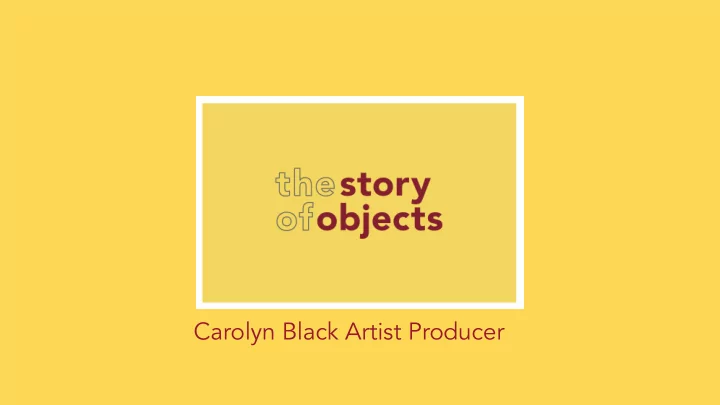

Carolyn Black Artist Producer
Th The origi ginal visi sion fo for Th The Story of f Ob Object ects in n 2014 2014
“Objects store and possess, take in and breath out the emotions with which they have been associated” (Daniel Miller, The Comfort of Things, 2008)
Sh Shou ould we we t try t y to f fix t x the m memories t that o obj bject cts ho hold ld b by r rec ecording ing t their heir s stories ies in s in some w e way? “Due to our finite ability to mentally store our memories, human societies have produced a series of devices for storing memory in extrabodily form. These have included notched bone implements, clay and stone tablets, carved stelae, and, at a later stage in history, maps, drawings, photographs, phonographs, and other recording technologies, and, finally, the computer. Each of these offers an increasing capacity for the storage of memory. Ea Each new technol olog ogy therefor fore acts s as s an ever mor ore effi ficient prop op for for hum human n mem emory ry.” .” Cambridge University Press, Memory and Material Culture by Andrew Jones
Ar Areas of expertis ise I have consult lted: • Contemporary archaeologists • Museum specialist • Curators • Artists • Health providers • Members of the public • Producers – for arts and radio • Digital providers and app developers
Wh Who is it fo for? Pa Particularly poignant for 45+ as they may be be de dealing w g with…… …….. .. • Downsizing their home • Parents death & associated increase in objects to resolve • Writing will to bequeath objects • Raised awareness of family • Raised awareness of mortality And And…… …….. .. for those who, for whatever reason, are having to reduce ownership of things
Wh What at i is t the S Story o of O Objects i invitat ation
Th The Disc scovery Ph Phase se During the discovery phase, a few options were explored, 30 second YouTube videos, like this one by Nancy Clemence (artist)
Catheri Catherine Cartw ne Cartwri rights f hts film i m inv nvites p tes peop eople e to b to be v e vul ulnera nerable….
Ot Other her out output uts incl nclud ude: e: Flash Fiction – taking the original (factual) stories as starting points to inspire another story (fictional) A workshop for dementia patients & themed workshops A cake! Audio files, suitable for radio broadcast Consultations with various sectors, including artists & museums
Wh Why is this diffe ferent to collections in mu muse seums? ms? Cultural commons & non-authoritative – no specialists required People choose to keep these things for emotional reasons Families and places can be connected by the lineage of a thing The dialogue is always around the object itself, not the person, yet the person is revealed
So w So what have I hat have I l lear earnt to d nt to date? ate? • Everyone has an object they would like to tell the story of • Sharing in an encounter group has a flattening impact on social hierarchies • Speaking through the object overcomes social discomfort • People know their objects, why they keep them and love them, very well. They can therefore articulate those objects. Emotion is key • As a producer, I have always run projects with clear outcomes. With SOO, the encounter is where the art resides, for most people, that is enough
Ques Questions ons ar arising ng: how how mig ight the process be be use sed d wi within the Universi sity Context? • In health and wellbeing fields? • Socially engaged practices? • Speech and articulation? • Talking about art? • Networking things? • A bolt-on for genealogy research? • How important are the stories?
Wh What do I wa want fr from you? Join me for an encounter session on Wednesday 23 rd Jo November nk about how your area of practice might contribute to the Think Thi Story of Objects process Talk to me about how the Story of Objects might inform your Ta own research and practice ider working towards a expanded research funding Con onside application to develop understanding
by Flow Contemporary Arts E: Carolyn@flowprojects.org.uk M: 07775938500 www.flowprojects.org.uk SUPPORTED BY HEIF FUNDING
Recommend
More recommend